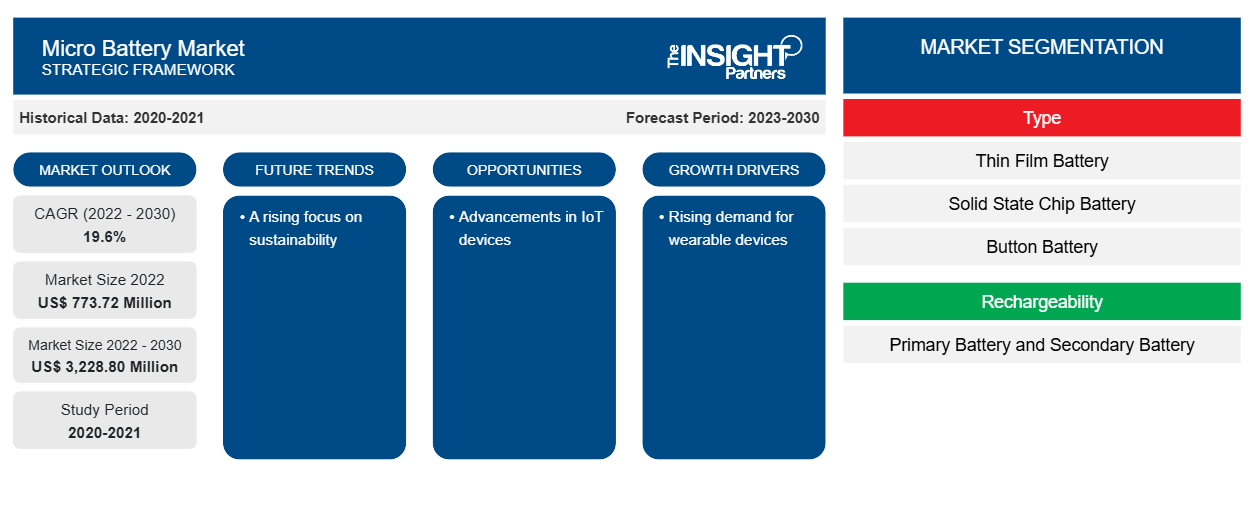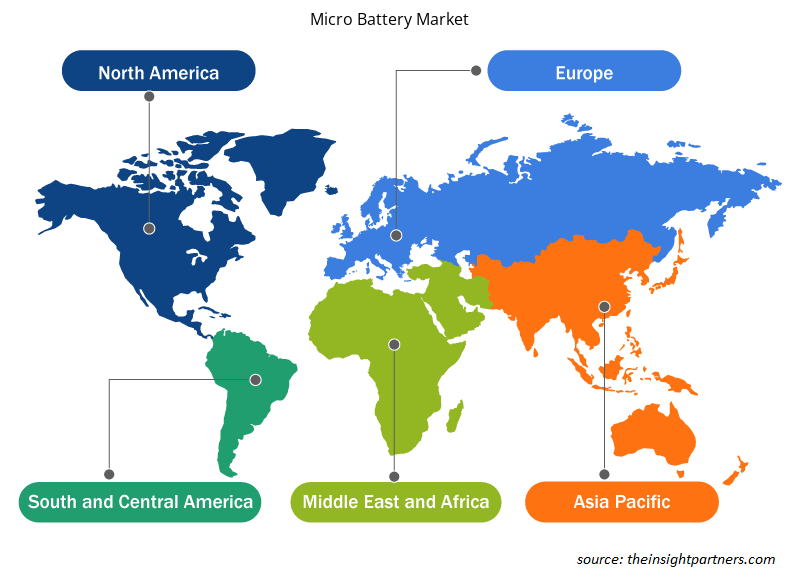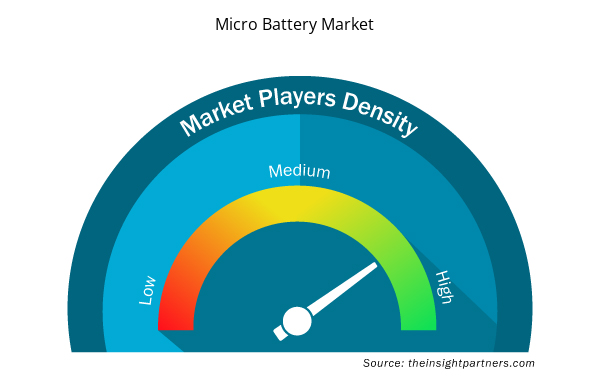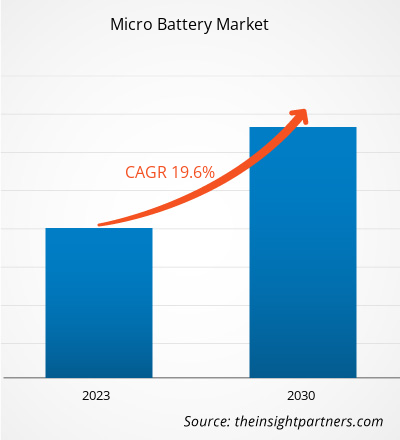The micro battery market size is projected to reach US$ 3228.80 million by 2030 from US$ 773.72 million in 2022. The market is expected to register a CAGR of 19.6% during 2022–2030. Rising demand for wearable devices and miniaturization of consumer electronics is likely to remain a key trend in the market.
Micro Battery Market Analysis
The micro battery market has grown significantly in recent years. Factors such as the shift towards wearable devices are contributing to the micro battery market growth. The global micro battery market is further boosted by the growing awareness of their advantages, such as a wide operating temperature range and high energy density. Expansion in the healthcare industry and advancements in IoT devices will create lucrative opportunities in the micro battery market.
Micro Battery Market Overview
In the world of small electronic systems and gadgets, micro batteries play a crucial role as they are specifically designed to provide power in situations where space is limited. Conventional larger batteries may not be suitable for devices such as hearing aids, sensors, medical implants, and other microelectronic devices due to their size limitations. This is where micro batteries come into play, serving as the preferred choice in such scenarios. The increasing adoption of wearable technology, coupled with the expansion of the semiconductor sector and the rise in private investments in technical research and development for Internet of Things (IoT) technology, drives the market.
Customize This Report To Suit Your Requirement
You will get customization on any report - free of charge - including parts of this report, or country-level analysis, Excel Data pack, as well as avail great offers and discounts for start-ups & universities
Micro Battery Market: Strategic Insights

- Get Top Key Market Trends of this report.This FREE sample will include data analysis, ranging from market trends to estimates and forecasts.
You will get customization on any report - free of charge - including parts of this report, or country-level analysis, Excel Data pack, as well as avail great offers and discounts for start-ups & universities
Micro Battery Market: Strategic Insights

- Get Top Key Market Trends of this report.This FREE sample will include data analysis, ranging from market trends to estimates and forecasts.
Micro Battery Market Drivers and Opportunities
Miniaturization of Consumer Electronics
The growing miniaturization of consumer electronics is a significant factor driving the growth of the micro battery market. In today's fast-paced world, consumer electronics have become integral to everyone's lives. From smartphones to wearable devices, the demand for smaller and more powerful gadgets continues to rise. As consumer electronics continue to shrink in size, traditional battery technologies struggle to keep up with the demand for compact and long-lasting power sources. Micro batteries, also known as micropower sources, have emerged as a solution to this problem. These tiny energy storage devices offer high energy density in a small form factor, making them ideal for powering the ever-shrinking consumer electronics.
Growing wearable devices
The rising focus towards physical fitness is driving the adoption of wearable devices as it help the user to monitor the oxygen level, number of steps, heart rate, and various other parameters. In addition, it also helps to view text messages, track location with GPS, and several other features. This wearable technology requires a battery solution for its efficient working, which drives the demand for micro batteries.
Micro Battery Market Report Segmentation Analysis
Key segments that contributed to the derivation of micro battery market analysis are the type, rechargeability, and application.
- Based on the type, the micro battery market is divided into thin film battery, solid state chip battery, and button battery. The thin film battery segment held the largest market share in 2022.
- By rechargeability, the market is segmented into primary battery and secondary battery. The primary battery segment held the largest share of the market in 2022.
- By application, the market is segmented into consumer electronics, smart packing, medical devices, wireless sensor nodes, and others. The consumer electronics segment held the largest share of the market in 2022.
Micro Battery Market Share Analysis by Geography
The geographic scope of the micro battery market report is mainly divided into five regions: North America, Asia Pacific, Europe, Middle East & Africa, and South & Central America.
North America holds a significant global market share in 2022. The awareness towards fitness is one the major factors driving the demand for wearable devices, which further complements the market growth. The demand for compact and miniature electronic devices is leading to the need for micro batteries. The investment in battery solutions creates a huge opportunity for the research and development of micro batteries. For example, in November 2023, the U.S. Department of Energy (DOE) announced up to US$3.5 billion from the Infrastructure Law to boost domestic production of advanced batteries and battery materials nationwide.
Micro Battery Market Regional Insights
The regional trends and factors influencing the Micro Battery Market throughout the forecast period have been thoroughly explained by the analysts at Insight Partners. This section also discusses Micro Battery Market segments and geography across North America, Europe, Asia Pacific, Middle East and Africa, and South and Central America.

- Get the Regional Specific Data for Micro Battery Market
Micro Battery Market Report Scope
| Report Attribute | Details |
|---|---|
| Market size in 2022 | US$ 773.72 Million |
| Market Size by 2030 | US$ 3,228.80 Million |
| Global CAGR (2022 - 2030) | 19.6% |
| Historical Data | 2020-2021 |
| Forecast period | 2023-2030 |
| Segments Covered |
By Type
|
| Regions and Countries Covered | North America
|
| Market leaders and key company profiles |
Micro Battery Market Players Density: Understanding Its Impact on Business Dynamics
The Micro Battery Market is growing rapidly, driven by increasing end-user demand due to factors such as evolving consumer preferences, technological advancements, and greater awareness of the product's benefits. As demand rises, businesses are expanding their offerings, innovating to meet consumer needs, and capitalizing on emerging trends, which further fuels market growth.
Market players density refers to the distribution of firms or companies operating within a particular market or industry. It indicates how many competitors (market players) are present in a given market space relative to its size or total market value.
Major Companies operating in the Micro Battery Market are:
- Molex LLC
- Murata Manufacturing Co Ltd
- Varta AG
- Duracell Inc
- RENATA SA
- Maxell Holdings, Ltd
Disclaimer: The companies listed above are not ranked in any particular order.

- Get the Micro Battery Market top key players overview
Micro Battery Market News and Recent Developments
The micro battery market is evaluated by gathering qualitative and quantitative data post primary and secondary research, which includes important corporate publications, association data, and databases. A few of the developments in the micro battery market are listed below:
- The US Department of Energy (DOE) announced the launch of the Microbattery Design Prize. This two-stage competition awards up to US$ 1.1 million in federal funding and performance and safety testing services with DOE national laboratories to innovative small-capacity battery design projects that yield improved performance, safety, and recyclability. (Source: Office of Energy Efficiency & Renewable Energy, Press Release, March 2023)
Micro Battery Market Report Coverage and Deliverables
The "Micro Battery Market Size and Forecast (2020–2030)" report provides a detailed analysis of the market covering below areas:
- Micro battery market size and forecast at global, regional, and country levels for all the key market segments covered under the scope
- Micro battery market trends, as well as market dynamics such as drivers, restraints, and key opportunities
- Detailed PEST/Porter's Five Forces and SWOT analysis
- Micro battery market analysis covering key market trends, global and regional framework, major players, regulations, and recent market developments
- Industry landscape and competition analysis covering market concentration, heat map analysis, prominent players, and recent developments for the micro battery market
- Detailed company profiles
- Historical Analysis (2 Years), Base Year, Forecast (7 Years) with CAGR
- PEST and SWOT Analysis
- Market Size Value / Volume - Global, Regional, Country
- Industry and Competitive Landscape
- Excel Dataset



Report Coverage
Revenue forecast, Company Analysis, Industry landscape, Growth factors, and Trends

Segment Covered
Type, Rechargeability, Application, and Geography

Regional Scope
North America, Europe, Asia Pacific, Middle East & Africa, South & Central America

Country Scope
This text is related
to country scope.
Frequently Asked Questions
What would be the estimated value of the micro battery market by 2030?
The estimated value of the micro battery market will be US$ 3228.80 million by 2030.
Which are the leading players operating in the micro battery market?
Molex LLC; Murata Manufacturing Co Ltd; Varta AG; Duracell Inc; RENATA SA; Maxell Holdings, Ltd; Seiko Instruments Inc; Riot Energy Inc; Panasonic Energy Co Ltd; and Enfucell Flexible Electronics Ltd are some of the key players operating in the micro battery market.
What is the future trend of the micro battery market?
A rising focus on sustainability is a key trend in the micro battery market.
What is the expected CAGR of the micro battery market?
The global micro battery market is estimated to register a CAGR of 19.6% during the forecast period 2022–2030.
What are the driving factors impacting the micro battery market?
Rising demand for wearable devices and miniaturization of consumer electronics are the key driving factors impacting the micro battery market.
Trends and growth analysis reports related to Energy and Power : READ MORE..
The List of Companies - Micro Battery Market
- Molex LLC
- Murata Manufacturing Co Ltd
- Varta AG
- Duracell Inc
- RENATA SA
- Maxell Holdings, Ltd
- Seiko Instruments Inc
- Riot Energy Inc
- Panasonic Energy Co Ltd
- Enfucell Flexible Electronics Ltd

 Get Free Sample For
Get Free Sample For